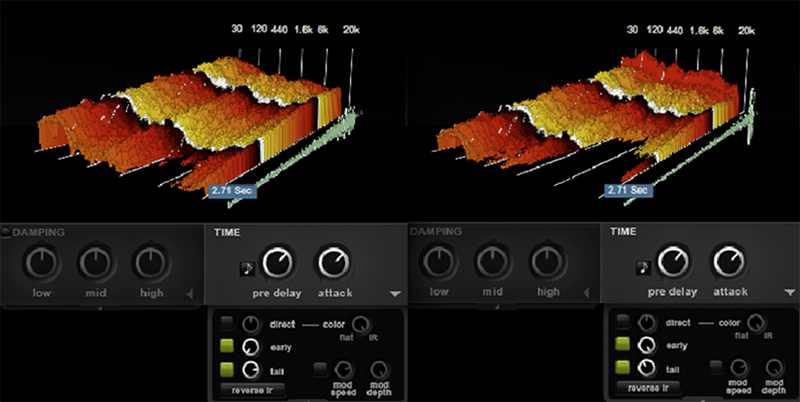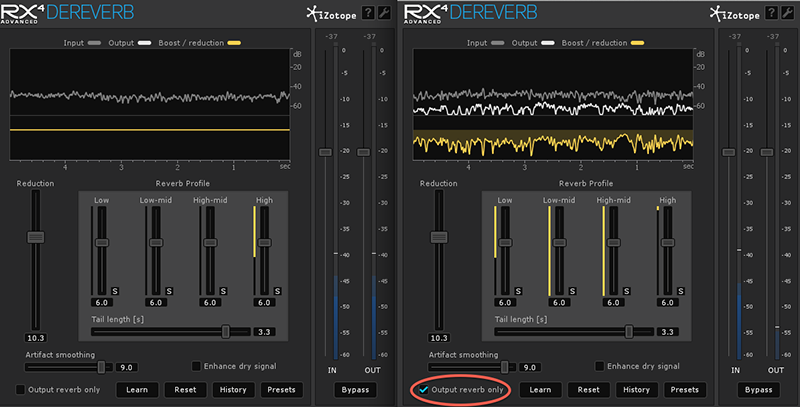‘We are talking in space, not in time’
in A Matter of Life and Death
(Michael Powell and Emeric Pressburger, 1946)
Making Sounds with Reverb
The third block of this composition used reverb VSTs to produce the sound material. It used the parameters of reverberation in order to ‘capture’ the reflections of sound, rather than keeping the direct sound source. The reverb settings were pushed to an extreme, creating strong artifacts which replaced the dry sound. The VST in use was Altiverb 7, which is based on physical impulse response convolution.
For this purpose, two main sources were chosen. This choice resulted from the theoretical discussion, mostly due to the need of finding a sound that had an interesting envelope for propagation. That is, a strong attack, a relatively long sustain and a smooth decay. In fact, inadvertently, the choice concerned a sound that is heavily dependent on its propagation. In other words, the common perception of this sound occurs more through its propagation in space rather than as a dry source. In that sense, it became quite difficult to erase the original source and use only the artifacts, because the artifacts were still as recognizable as the original sound.
However, the whole project began with the idea of unreality
, thus it was necessary to erase any possibility of recognizing the sound; and yet, it was necessary to keep some degree of relatability in order to establish a reference based on which the feeling of unreality
could emerge. Due to this, the Impulse Response of an open field, rather than an indoor space, was more convenient. This VST offers a certain number of options and the distant building pre-set allowed for smoothing the source and avoiding immediate recognition. That can also be understood in the comparative illustration bellow.
Fig. 3.1 – On the left, pre-set of indoor space: Allaire Great Hall; on the right pre-set of outdoor space: open field: distant building
3.1. Early Reflections and Tails
Due to the need to conceal the source, the strategy depended heavily on the manipulation of the reverb parameters. With this particular sound, keeping the early reflections would denounce the source immediately. On the contrary, prolonging the tail of the reverb would help to diffuse the detail of the sound, therefore making it harder to recognize.
Fig. 3.2 – On the left, pre-set of outdoor space: open field: distant building; no early reflections and longer tail; on the right, maximum early reflections with no tail. Both without direct sound
And yet, if the sound was continuous for too long, or repeated, it would still be recognizable. For this reason, it was necessary to render these initial reflections and then put the new files through a range of other processes.
3.2. Dereverb
Besides common processes such as pitch-shifting, low- and high-passes, the most peculiar process was to invert the purpose of the VST developed by iZotope, Dereverb RX4. The initial utility of this VST is to clean the reflections in a sound, but for audition purposes there is an option to listen to output reverb only, just so one can listen to what is being cleaned from the sound. Once the dry sound source was affected by Altiverb it was put through this VST and the spectrum, usually excluded
, became a new rendered file. In this way, the original dry sound source was dismissed and only this extreme reverbed
files were used.
Fig. 3.3 – On the left, iZotope Dereverb Rx4 reducing reflected sound; on the right iZotope Dereverb Rx4 outputting reverb only
And yet, the original source was still recognizable, precisely because the usual perception of this object occurs through its reflections in space. For that reason, each of these new sound files went through compression, low- and high-pass filters. It was necessary to keep the extremes, avoiding the middle frequencies, the most identifiable part of the spectrum.
However, this process created very thin sounds with a flat, close to empty, spectrum. In order to avoid that, these tracks were duplicated and set with a pitch-shift with one octave up, another track with a pitch-shift with an octave down and having them trying to prevail over the other. Still, the issue of recognition remained. If the sound became too continuous, too repetitive or too dynamic (enveloping), it would be almost recognizable again.
3.3. The Second Sound Source
For that reason, the idea of a second source emerged. The perception of the first source happens heavily due to its movement in space and the consequential delay. It transports the frequencies along the space and its perception occurs through the reflections rather than the original source. However, it is composed of a number of layers that could be separated and evaluated for the purposes of this composition.
In fact, a common approach to create this sound in a movie scene, for example, would be to divide it into layers and have several props performing each layer. This is also similar to the approach of sound synthesis, as Farnell exemplifies in Designing Sound (2012), which is also composed of several layers. As mentioned above, the first sound source was chosen according to its envelope, and so was the second source. This time, the choice focused on a very short attack and decay, with almost no sustain. The sound in question could be one of the fictional sources to compose the first sound. It allowed isolating one of its components and exploring the same process at a deeper level. However, because it is already a hypothetical extraction
of the first sound source, it would denounce it even more: it is that awkward moment in a process when a fake
sound is more real
than the original source itself – something which is in fact very familiar to Foley Art. In that sense, it defeated the purpose even more than the first source.
Slowly, increasing or decreasing the early reflections and the tail of the reverb transformed this sound into something completely different. In this case, the early reflections were necessary due to the short attack of the source. Without them, there would not be enough material to extend and propagate. Paradoxically, it started resembling a concrete reference, which has nothing to do with either of the sources in use. On the one hand, the idea was to transform the sources so they would become unrecognizable. On the other hand, the aim was to make sounds with the reverb tool itself and have the result of the process be absolutely digital, fictional, and abstract. It is indeed relatable, perhaps even misunderstood as something existing-in-the-world
and nominable, but its core and content are unreal. Unlike the first source, which is usually perceived through its reflections in space, this second source is in fact perceived almost dry, directly. Wetting
this sound turned it into something else.
3.4. Going Back
The processed reversed the propagation of a sound originally reflected in space and erased the frequencies that establish the referentiality of the experience. Additionally, it used a second – completely decontextualized – source, and by inserting it in this process as a context, this sound gained second and third meanings.
Throughout the research, it was noticeable that reverb is considered a technique to fix issues in propagation; for example, in concert halls, or as a tool of fiction in film; for example, as the dramaturgic purpose of the end scene of The Good, the Bad and the Ugly (Sergio Leone, 1966). However, rather than a technique or a function, it can be used as an aesthetic principle; for example, as in the design of Blade Runner 2049 (Denis Villeneuve, 2017), which recalls the same spatial acoustics of Ridley Scott’s version (1982); or as in Luigi Nono’s A Pierre. Dell’azzurro Silenzio, Inquietum (1985) or Omaggio a György Kurtág for Contralto (1983-86). As part of the feedback process, reverb can also produce musical content, as in Eliane Radigue’s Feedback Works 1969-1970. The goal of this segment within the entirety of the composition was to use sound material which is usually avoided, or at most used to support the direct sound. It aimed mostly at producing and using reflections and listening to these as a possible stand-alone source, without the need for a direct or dry source. In the end, it is a proposal of reduced listening for a digital generation.






